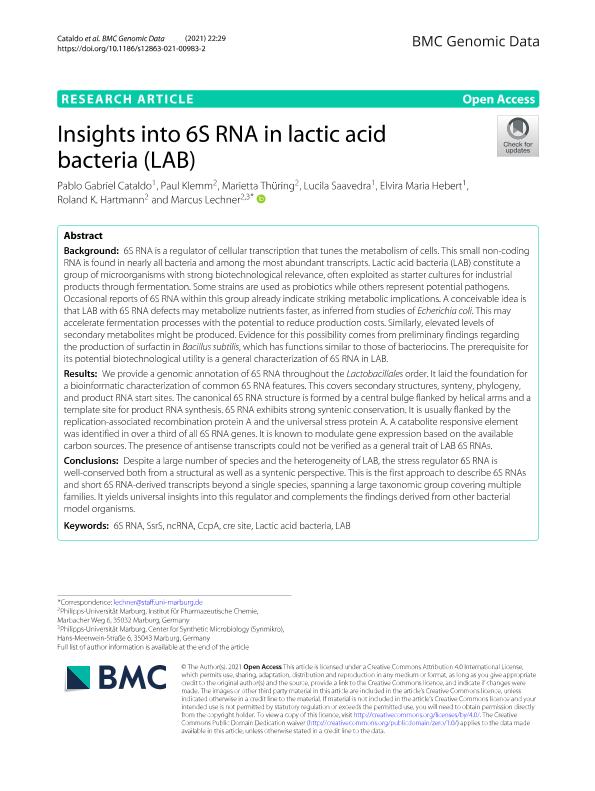Artículo
Insights into 6S RNA in lactic acid bacteria (LAB)
Cataldo, Pablo Gabriel ; Klemm, Paul; Thüring, Marietta; Saavedra, Maria Lucila
; Klemm, Paul; Thüring, Marietta; Saavedra, Maria Lucila ; Hebert, Elvira Maria
; Hebert, Elvira Maria ; Hartmann, Roland K.; Lechner, Marcus
; Hartmann, Roland K.; Lechner, Marcus
 ; Klemm, Paul; Thüring, Marietta; Saavedra, Maria Lucila
; Klemm, Paul; Thüring, Marietta; Saavedra, Maria Lucila ; Hebert, Elvira Maria
; Hebert, Elvira Maria ; Hartmann, Roland K.; Lechner, Marcus
; Hartmann, Roland K.; Lechner, Marcus
Fecha de publicación:
03/09/2021
Editorial:
BioMed Central
Revista:
BMC Genomic Data
ISSN:
2730-6844
Idioma:
Inglés
Tipo de recurso:
Artículo publicado
Clasificación temática:
Resumen
Background: 6S RNA is a regulator of cellular transcription that tunes the metabolism of cells. This small non-coding RNA is found in nearly all bacteria and among the most abundant transcripts. Lactic acid bacteria (LAB) constitute a group of microorganisms with strong biotechnological relevance, often exploited as starter cultures for industrial products through fermentation. Some strains are used as probiotics while others represent potential pathogens. Occasional reports of 6S RNA within this group already indicate striking metabolic implications. A conceivable idea is that LAB with 6S RNA defects may metabolize nutrients faster, as inferred from studies of Echerichia coli. This may accelerate fermentation processes with the potential to reduce production costs. Similarly, elevated levels of secondary metabolites might be produced. Evidence for this possibility comes from preliminary findings regarding the production of surfactin in Bacillus subtilis, which has functions similar to those of bacteriocins. The prerequisite for its potential biotechnological utility is a general characterization of 6S RNA in LAB. Results: We provide a genomic annotation of 6S RNA throughout the Lactobacillales order. It laid the foundation for a bioinformatic characterization of common 6S RNA features. This covers secondary structures, synteny, phylogeny, and product RNA start sites. The canonical 6S RNA structure is formed by a central bulge flanked by helical arms and a template site for product RNA synthesis. 6S RNA exhibits strong syntenic conservation. It is usually flanked by the replication-associated recombination protein A and the universal stress protein A. A catabolite responsive element was identified in over a third of all 6S RNA genes. It is known to modulate gene expression based on the available carbon sources. The presence of antisense transcripts could not be verified as a general trait of LAB 6S RNAs. Conclusions: Despite a large number of species and the heterogeneity of LAB, the stress regulator 6S RNA is well-conserved both from a structural as well as a syntenic perspective. This is the first approach to describe 6S RNAs and short 6S RNA-derived transcripts beyond a single species, spanning a large taxonomic group covering multiple families. It yields universal insights into this regulator and complements the findings derived from other bacterial model organisms.
Palabras clave:
6S RNA
,
CCPA
,
CRE SITE
,
LAB
,
LACTIC ACID BACTERIA
,
NCRNA
,
SSRS
Archivos asociados
Licencia
Identificadores
Colecciones
Articulos(CERELA)
Articulos de CENTRO DE REFERENCIA PARA LACTOBACILOS (I)
Articulos de CENTRO DE REFERENCIA PARA LACTOBACILOS (I)
Citación
Cataldo, Pablo Gabriel; Klemm, Paul; Thüring, Marietta; Saavedra, Maria Lucila; Hebert, Elvira Maria; et al.; Insights into 6S RNA in lactic acid bacteria (LAB); BioMed Central; BMC Genomic Data; 22; 1; 3-9-2021; 1-15;29
Compartir
Altmétricas



